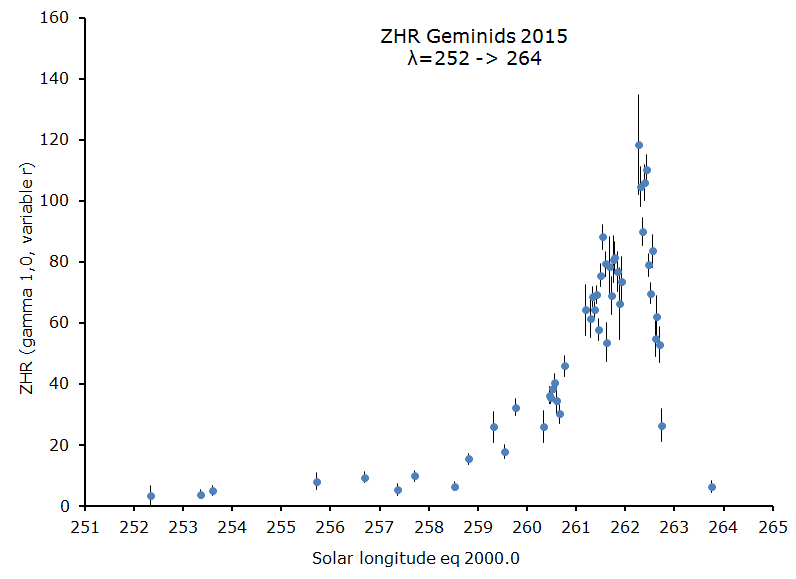
The 2015 Geminids have been successfully observed and an analysis has been made, based on all available data. The maximum activity occurred beyond the European observing window and could not be taken into account due to a lack of data from the Far East. The rising slope of the activity profile before the predicted time of maximum activity displayed less strong activity compared to a number of previously well observed Geminid returns. The 2015 Geminid observations are not conclusive about the question whether or not the maximum activity of the Geminid meteor shower is on the wane.
1 Introduction
The Geminids are the most active meteor shower of the ‘Big Three’. During a complete clear night 13–14 December any active and experienced observer may count more than 1000 meteors in a single night! The shower displays also a nice brightness profile. Before and during the maximum the fainter meteors are prominent, immediately followed by a significant increase in the average brightness. This results almost always in a number of fireballs. A nice and probably rather extreme example of this occurred in 2007 (Vandeputte, 2008). At this occasion about 18 different Geminid meteors were seen with magnitudes between -3 and -8 in just five hours of time while observing in Portugal!
The author has published a detailed article in 2010 about the Geminids (Miskotte et al., 2010; Miskotte et al., 2011). The purpose of this article was to check if we could detect any variation in the maximum activity over the years. From this analysis it occurred that the maximal Geminid ZHR varied between 80 and 100 in the 1980s. The 1990s produced ZHRs between 100 and 140. The first decade since 2000 produced also maximal ZHRs up to 140, although 2009 produced somehow lower ZHRs like in 2001. The first next opportunity to collect data for comparison with the past was 2012 as in that year we watched the same solar longitude interval as in 2006 and 2004. Unfortunately this attempt failed completely. We got another chance in 2015 although the maximum would take place during daylight hours. Asia was the place to be for the maximum. Unfortunately the weather was very unstable in Europe and only Central and Eastern Europe offered good chances for longer periods with clear sky between 13 and 15 December.
2 The available data
Sadly the data that was usual available via the IMO website with the ZHR-activity-on-the-fly wasn’t immediately available. Begin of March 2016 I received some hyperlinks from Rainer Arlt to access the available IMO data. Little bit later the ZHR-graphs-on-the-fly appeared again on the IMO website.
The data from each observer was checked and a selection was made. Data with limiting magnitudes of less than +5.9 or with a cloud cover percentage above 10% (F = 1.10) were rejected. If these rejected reports included useable observing intervals of at least 0.45 hour with less than 10% cloud cover and a limiting magnitude better than +5.9, then these intervals were still selected for our dataset. Beyond the data obtained from the IMO website, the author also contacted a number of visual observers who did not report to IMO, to ask them to provide their observational data. This resulted in a significant number of extra Geminid data.
In total we collected data for 9724 Geminids and 1820 sporadic meteors. Table 1 lists the names of the visual observers whose data has been used in this analysis. For each observer the perception coefficient is given, which was known for most of the observers what saved some time for this analysis.
As soon as all data were entered into the ZHR spreadsheet, the typical global distribution of the observers worldwide became visible. A lot of data from Europe (20 observers), again somewhat less observers from America (6 observers) and only one single observer from the Far East, Australia, New Zealand and China. There are about 10 to 15 observers active in China but unfortunately they appear to work in light polluted cities as most observers report limiting magnitudes of +4 to +5 which is too low to make any reliable analyses. The data from Australia and New Zealand did not qualify because of the too low radiant elevation.
The population index R has been derived as described by Miskotte (2016) according to the criteria to use only the most relevant data for the calculation of the population index r and the ZHR. To select the data for the calculation of the r-values the difference between the average limiting magnitude and the average magnitude of the Geminids had to be less than 4.5. For data after the time of maximum activity (s.l. 262.2°) this was set to less than 5.0 because of the significant increase in brightness of the Geminids. 5944 Geminids fulfilled the criteria and the interesting result has been listed in Table 2.
Table 1 – List of all observers whose data has been used in this analysis. A complete list of observers who reported Geminid data can be found on the IMO website.
| Name | IMO code | Cp | Year | Inter
vals |
Country |
| Marina Arnaut | ARNMA | 0.8 | 2015 | 23 | Serbia |
| Jure Atanackov | ATAJU | 2.0 | 2015 | ~ | Slovakia |
| Pierre Bader | BADPI | 1.0 | 2015 | ~ | Germany |
| Orlando Benítez Sánchez | BENOR | 1.1 | 2015 | 15 | Spain |
| Felix Bettonvil | BETFE | 1.0 | 2007 | 10 | France |
| Ilija Bogdanovic | BOGIL | 0.7 | 2015 | 17 | Serbia |
| Ljubomir, Brankovic | BRALJ | 1.0 | 2015 | 36 | Serbia |
| Andreas Buchmann | BUCAN | 1.1 | 2015 | 4 | Switzerland |
| David Buzgo | BUZDA | 1.7 | 2015 | 21 | Serbia |
| Sietse Dijkstra | DIJSI | 1.0 | 2013 | ? | Germany |
| Milica Dodevski | DODMI | 1.0 | 2015 | ~ | Serbia |
| John Drummond | DRUJO | 1.0 | 2015 | ~ | New Zeeland |
| Christoph Gerber | GERCH | 1.0 | 2015 | ~ | Germany |
| Ljubica Grasic | GRALJ | 1.0 | 2015 | 8 | Serbia |
| Robin Hegenbarth | HEGRO | 1.0 | 2015 | 3 | Germany |
| Carl Hergenrother | HERCA | 1.2 | 2015 | 5 | U.S. |
| Carl Johannink | JOHCA | 1.2 | 1995 | 30+ | Germany |
| Paul Jones | JONPA | 1.0 | 2015 | 7 | U.S. |
| Javor Kac | KACJA | 1.0 | 2015 | 36 | Slovakia |
| Ralf Koschack | KOSRA | 1.0 | 2015 | 5 | Germany |
| Anna Levina | LEVAN | 0.7 | 2014-15 | 11 | Israel |
| Mike Linnolt | LINMI | 1.0 | 2015 | ~ | U.S. |
| Caslav Lukic | LUKCA | 1.0 | 2015 | ~ | Serbia |
| Milica, Maletic | MALMI | 1.0 | 2015 | 25 | Serbia |
| Adam Marsh | MARAD | 1.0 | 2015 | ~ | Australia |
| Pierre Martin | MARPI | 1.0 | 2007 | 30+ | Canada |
| Koen Miskotte | MISKO | 1.2 | 1995 | 30+ | Netherlands |
| Sirko Molau | MOLSI | 0.6 | 2015 | 14 | Germany |
| Pedro Pérez | PERPE | 1.0 | 2015 | ~ | Spain |
| Nastasija Petkovic | PETNA | 1.0 | 2015 | ~ | Serbia |
| Antonija, Radulovic | RADAN | 0.9 | 2015 | 16 | Serbia |
| Ina Rendtel | RENIN | 0.9 | 2015 | 20 | Germany |
| Jurgen Rendtel | RENJU | 1.0 | 2007 | 30+ | Germany |
| Miguel Rodriguez-Alarcon | RODMI | 1.0 | 2015 | ~ | Spain |
| Terrence Ross | ROSTE | 0.9 | 2014 | 24 | U.S. |
| Terrence Ross | ROSTE | 1.0 | 2015 | 39 | U.S. |
| Mirco Saner | SANMI | 1.0 | 2015 | 10 | Switzerland |
| Branislav Savic | SAVBR | 1.1 | 2014 | 11 | Serbia |
| Branislav Savic | SAVBR | 1.1 | 2015 | 45 | Serbia |
| Stefan Schmeizer | SCHST | 0.7 | 2014 | 10 | Romania |
| Tunc Tezel | TETZU | 1.0 | 2015 | ~ | Turkey |
| Snezana, Todorovic | TODSN | 0.8 | 2014-15 | 29 | Serbia |
| Oliver Wusk | WUSOL | 0.8 | 2015 | 22 | Germany |
| Hu Yandong | YANHU | 1.0 | 2015 | ~ | China |
Table 2 – Population index r for the Geminids 2015 obtained for the magnitude intervals [-2;+5] and [-1;+5].
| Date
Dec. 2015 |
Until
UT |
Continent | Solar Long. eq. 2000.0 | r[-2;5] | r[-1;5] |
| 10-12 | 4.50 | EUR/US | 257.56 | ~ | 3.22 |
| 11-12 | 5.50 | EUR/US | 258.66 | ~ | 2.82 |
| 11-12 | 22.83 | EUR | 259.38 | ~ | 2.74 |
| 12-12 | 8.50 | US | 259.76 | 2.60 | 2.70 |
| 13-12 | 0.00 | EUR | 260.42 | 2.12 | 2.09 |
| 13-12 | 19.50 | EUR | 261.24 | 2.95 | 2.90 |
| 13-12 | 22.50 | EUR | 261.37 | 2.40 | 2.37 |
| 14-12 | 1.50 | EUR | 261.50 | 2.67 | 2.66 |
| 14-12 | 4.50 | EUR | 261.63 | 2.07 | 2.18 |
| 14-12 | 7.50 | US | 261.76 | 2.14 | 2.06 |
| 14-12 | 19.50 | EUR | 262.26 | 1.78 | 1.78 |
| 14-12 | 22.50 | EUR | 262.39 | 1.32 | 1.30 |
| 15-12 | 01.50 | EUR | 262.52 | 1.70 | 1.73 |
| 15-12 | 04.50 | EUR | 262.65 | 1.61 | 1.58 |
There is a very obvious decrease to be seen from 14 December 1h00m UT.
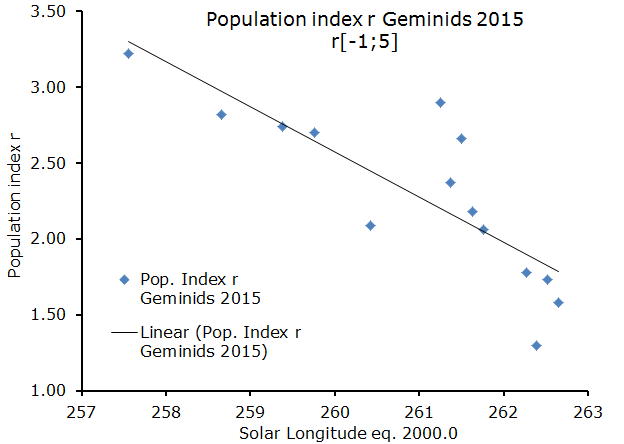
Figure 1 – Population index R for the 2015 Geminids based on 5944 Geminids.
3 The results of the ZHR calculations
The ZHRs are calculated according to the method of Peter Jenniskens (Jenniskens, 1994 ; Miskotte and Johannink, 2005):
ZHR = n * (sin h)–γ * r (6.5-LM) * Cp-1/ Teff
The value γ has been set to 1.0 for the radiant elevation correction. After that all the data had been entered in the ZHR spreadsheet, the values for Cp and the obtained r-values were added. During the input procedure the following aspects were carefully checked:
- Effective observing time: for the nights 12–13, 13–14 and 14–15 December only half hour intervals were used. However, some observers do report shorter intervals and these have been summed where possible. Time bins of minimal 0.4 and maximal 0.6 hour have been used. For instance an observing session of 0.35 hour has not been used. For the other nights the usual hourly counts were used (0.75 to 1.5 hour).
- Only observations done with a limiting magnitude of +5.9 or better were used.
- Observations with the radiant elevation less than 30 degrees were not used.
- Observations done with some obstruction, mostly due to clouds, larger than F = 1.10 were not used.
At the next step the ZHR for each observer was considered using the auto filter in Excel. For some extreme outliers the possible causes were checked. This may be due to a too low or too high estimated limiting magnitude, but in some cases this might be due to erroneous input of the geographical coordinates. Finally 8758 Geminids were selected out of the 9724 that were available for the ZHR profile. By the way, the total number of Geminids reported on the IMO website was 11595. The percentage of usable observations is a much better score than for the 2015 Perseids. A possible explanation is that the Geminids were more observed by experienced ‘die-hard’ observers, while during the summer more casual observers are involved. The resulting ZHR graph is shown in Figure 2.

Figure 2 – The complete ZHR graph for the 2015 Geminids based on 8758 Geminids and the calculated r-values in Table 1, The zenith attraction γ was set as 1.0.
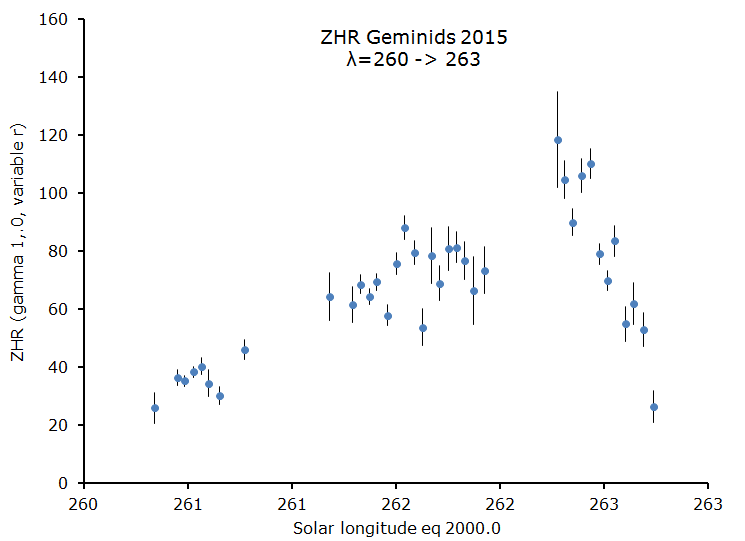
Figure 3 – The Geminid activity for the nights 12–13, 13–14 and 14–15 December 2015.
In Figure 3 we zoom in on the period 12–13 until 14–15 December 2015. The gaps in the curve are due to the lack of data from the Pacific Ocean and Asia. It can be very well seen how the activity profile shows an increase in activity during the night of 12–13 December, which continues to increase the next night, although with some ups and downs. It could be that there is some peak around s.l. 261.6°. The ZHR varied this night between 60 and 80. The night of 14–15 December shows a rapid decrease in activity, from a ZHR = 120 at the start of the night (over Europe) to a ZHR = 20 around s.l. 262.8°. The decrease in activity is much steeper than the increasing slope before the maximum, this skew activity profile is a phenomenon that has been observed for many years now. On the observing field the observers noticed very well how fast the activity decreases during the night. In most cases this goes together with many brighter Geminids. ZHR calculations for 14 December 2015 at 20h00m UT suggest that the ZHR was still slightly higher. Unfortunately these were calculations with lower radiant elevation which were disregarded for the final result. The maximum occurred a few hours earlier.
4 Comparing with other Geminid years
I would like to compare the Geminid activity with previous successful years, just like in (Miskotte et al., 2010; Miskotte et al., 2011). Let’s compare the conclusion made from the 2010 analysis. For the 1980s we found maximum ZHR-values in the range 80–100. In the 1990s this increased from about 100 to 140 and also after the year 2000 maximum ZHRs were found around 120–140. For the year 2009 we found a slightly lower peak value than in 2001. These were two years during which the peak could be observed. The question rose whether or not the maximum rates of the Geminids were declining.
The year 2015 fits in the series 1983–1991–1999–2007. Luckily the Geminid observations for the years 1983, 1991 and 2007 were successful. The analysis from 2010 (Miskotte et al., 2010) had been done with fixed r-values. Until solar longitude 262.2, r = 2.50 was assumed and after this solar longitude r = 2.30 was assumed. This has been done again in order to calculate in the same way like we did in 2010. There is, unfortunately, one important difference with the calculations that we made in 2010. In 2010 the ZHR data was based on Dutch Meteor Society data only, but since less DMS observers were active in 2015 we are now depending from IMO data. This complicates the comparison between good Geminid years.
During the night 13–14 December 2015, Carl Johannink, Sietse Dijkstra and the author observed the Geminids from the Black Forest (Miskotte, 2015). Once arrived at the observing field the observers noticed that the activity was rather disappointing. The first ZHR calculations confirm this. Also the observations by Jürgen Rendtel yield low ZHR values of 40–50 to 65 at the end of the night. Hence the series 1983–1991–2007 is ideal to verify whether the 2016 activity was at a higher, or the same, or at a lower level compared to previous years. Unfortunately no observations of the maximum, which occurred over the Far East, became available. For reason of completeness we include the 2015 Geminid ZHR curve (Figure 4) like given in Figure 2, but based on the fixed r-value like described above.
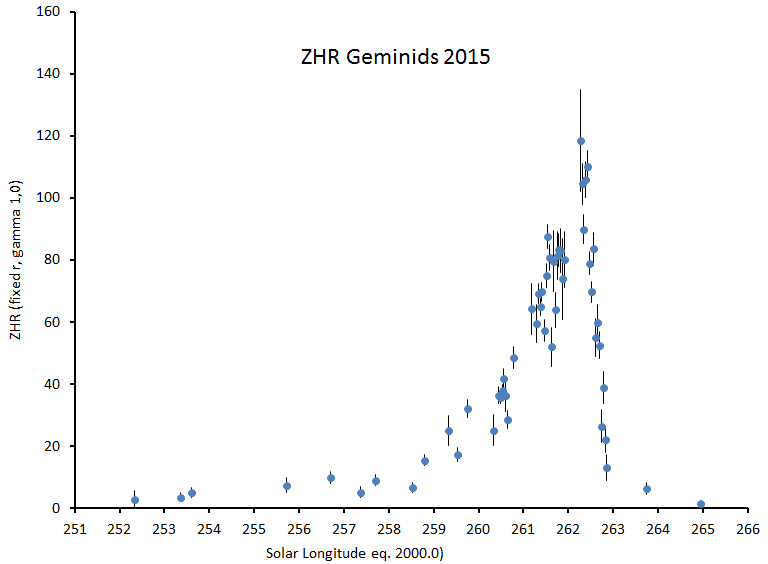
Figure 4 – The complete ZHR graph for the 2015 Geminids based on 8758 Geminids and a fixed r-value of 2.5 before s.l. 262.2 and r = 2.30 after this s.l.
The years 2007–2015
Good observations were obtained during both years for the nights 12–13, 13–14 and 14–15 December. The comparison of both datasets is displayed in Figure 5. It is obvious that the 2015 activity profile is well in step with that of 2007 for the nights 12–13 and 14–15 December. The level of the activity remains well below that of 2007 during the night of 13–14 December, but towards the end of the night the ZHR values for 2007 and 2015 seem to converge towards each other. For clarity; we consider a slightly disappointing activity level at the rising shoulder of the Geminid ZHR curve towards the Geminid maximum. Unfortunately there is no data available for the real Geminid maximum around s.l. 262.2°.
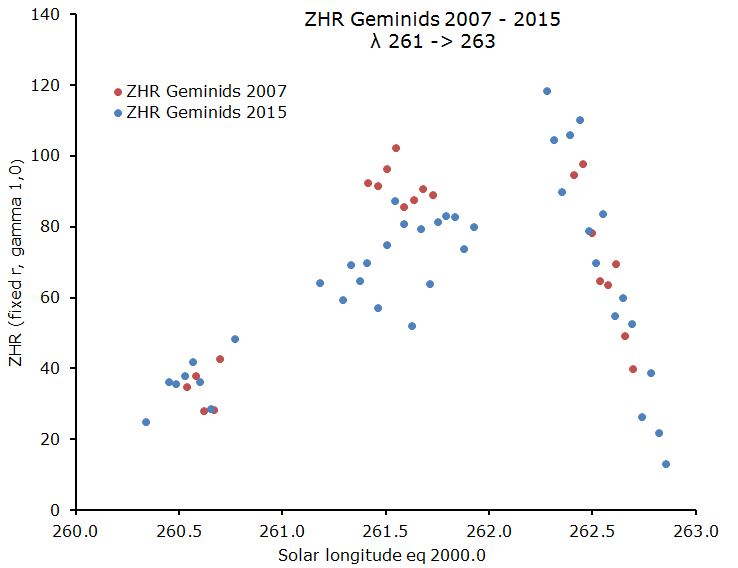
Figure 5 – The ZHR curves for the Geminids 2007 and 2015. It is nice to see the coincidence of the ZHR values for the night 14–15 December (Europe and North America). These ZHR curves are based on 5767 Geminids from 2007 and 8560 Geminids from 2015.
I checked if the ZHR values obtained by MISKO, JOHCA and DIJSI drag the ZHR curve to lower values, but that is not the case. Also fatigue seems to be ruled out as other observers report comparable ZHR values, sometimes a bit higher and sometimes a bit lower as well.
In order to make a comparison between the datasets of 2007 and 2015 for the night of 13–14 December with the same observers for both years I plotted the ZHR values in Figure 6. The result is rather striking.
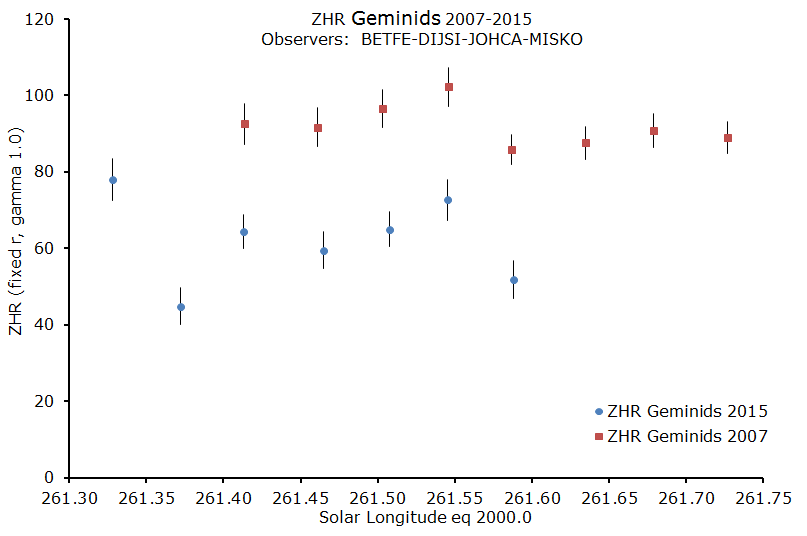
Figure 6 – Comparing ZHR-values based on data of observers BETFE, DIJSI, JOHCA and MISKO. It is notable that the ZHR-values display a similar course, although that the activity level in 2015 was ~30% lower than in 2007. These ZHR curves are based on 3128 Geminids for 2007 and 1141 Geminids for 2015.
Altogether the size of the dataset is too small to draw the conclusion as if the Geminid activity is on the wane. The lack of data about the maximum activity does not allow any solid conclusions, only the rising shoulder of the activity profile in the night of 13–14 December 2015 from Europe indicates a weaker level in the activity compared to 2007.
2016 compares well with the year 1991. In that year we also had rather disappointing ZHR values for the night
13–14 December compared to 1983 while the night 14–15 December had a comparable activity level as in 1983. At the occasion I suggested the eruption of the volcano Pinatubo at the Philippines as a possible explanation. Due to the presence of a huge amount of dust particles in our atmosphere, the fainter Geminids would have been less visible because of the stronger extinction at lower elevations at the sky, while that influence would have been less in the night of 14–15 December because of the occurrence of more brighter Geminids due to the mass sorting effect known in the Geminid stream.
The years 1991–2015
As the activity level during the night 13–14 December 1991 was considerable lower than in 1983, we have also compared 1991 with 2015. Only the nights 13–14 and 14–15 December could be compared as 12–13 December 1991 remained overcast in the Netherlands.
Are there any agreements? The result is displayed in Figure 7. Again the rather scattered activity distribution during the night 13–14 December is striking (between s.l. 261.5° and 261.8°), while the ZHR values at the decreasing shoulder of the profile for the night 14–15 December are more closely to each other. The activity in 1991 between s.l. 261.5° to 261.8° (13–14 December 1991) was a little bit lower than in 2015.
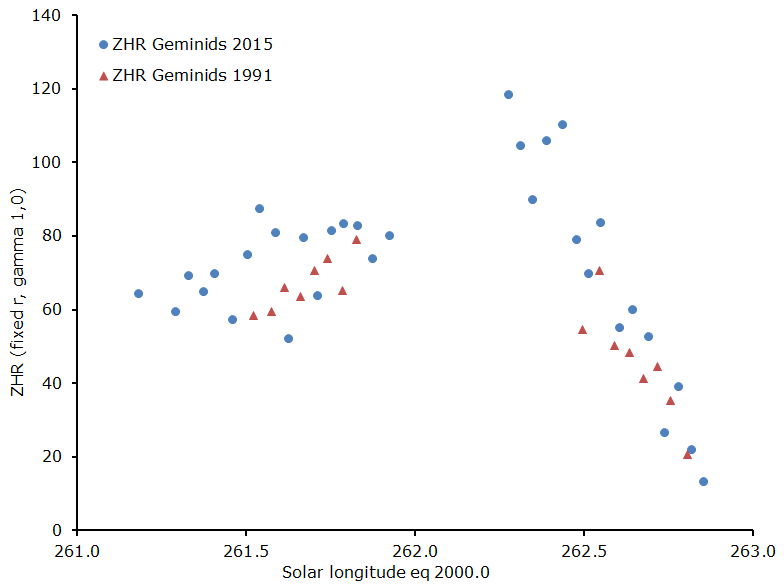
Figure 7 – The ZHR curves for the Geminids 1991–2015. The ZHR values were calculated for 4207 Geminids in 1991 and 7149 Geminids in 2015.
The years 1983–2015
Finally a comparison has been made with 1983, see Figure 8. It is obvious that the activity in 2015 was slightly lower than in 1983 but the differences can be neglected. Not mentioning the young observers of that time who are being compared with the old ones of today, 32 years later. Luckily the recent calculated Cp values solve this problem to a large extend.
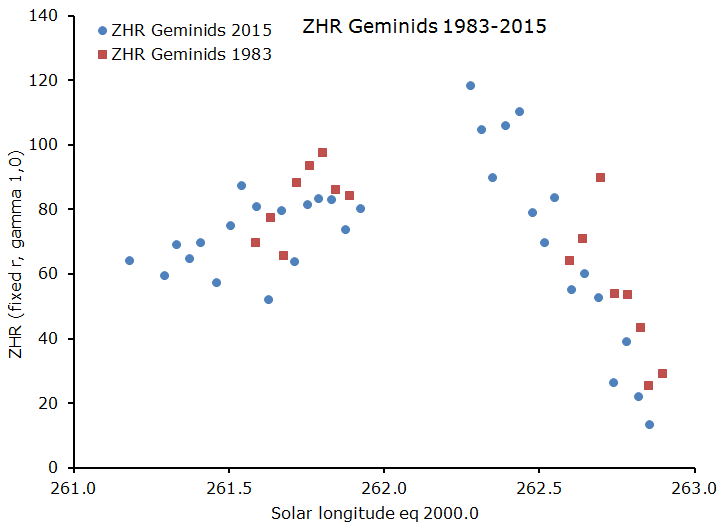
Figure 8 – The ZHR curves of the Geminids 1983 and 2015 based on respectively 1659 and 7149 Geminids.
5 Conclusions and challenges
The Geminids displayed a nice activity over Europe in the night of 14–15 December 2015. During the night 13–14 December 2015 the ZHR as obtained from Europe appears to be somewhat less than the same period in s.l. in 2007. Unfortunately there is no good data of the maximum around s.l. 262.2°. Based on the available observations from 2015 we cannot provide a solid prove that the Geminid activity is on the wane. It isn’t clear what could be the cause for the lower ZHR in the ascending branch of the activity profile. Also the rather scattered appearance of the activity curve towards the maximum is rather confusing. The appearance of multiple sub maxima could be an explanation or a lower increase may be due to a later occurrence of the Geminid maximum.
We are missing good observations for the 2015 maximum. Therefore it is important that the maximum should be well observed in 2017, in that year it is best visible from Europe. That year fits well in the series 1985 (well observed), 1993 (not observed), 2001 (well observed) and 2009 (well observed). In 2009 the activity was slightly less than in 2001, hence 2017 offers a good opportunity to verify if the lower ZHR-values recorded in 2009 were just a fluctuation or a more structural begin of the wane of the Geminid activity.
In 2017 we have the closest approach of the Geminid parent body to the Earth orbit during the Geminid maximum. 3200 Phaeton will get as close as 0.088 AU from the Earth. From research done in 2010 (Miskotte et al., 2010; Miskotte et al., 2011) there could be a possibility to see more bright Geminids. However the indications for this are rather weak and may also be due to statistical fluctuations. The way to find the truth is to go into the field and to observe the impressive Geminids!
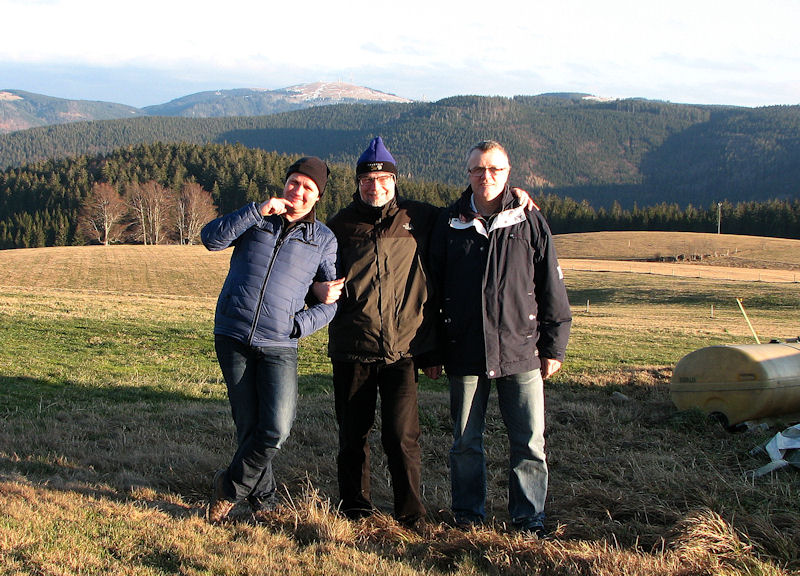
Figure 9 – From left to right: Sietse Dijkstra, Carl Johannink and Koen Miskotte at their observation site near the small village of Oberried-Hofsgrund at the Black Forrest were they succesfully observed the Geminids 2015. In the background the Feldberg.
Acknowledgment
Many thanks to Carl Johannink, Peter Bus and Michel Vandeputte for their careful proofreading of this paper and for their suggestions which have been taken into account. I thank Paul Roggemans for the translation of this article.
References
Vandeputte M. (2008). “Grootse Geminidenzwerm boven Portugal”. eRadiant 2008-2, 42–53.
Miskotte K., Johannink C., Vandeputte M. and Bus P. (2010). “Geminiden: 30 jaar waarnemingen (1980-2009)”. eRadiant 2010-6, 152–186.
Miskotte K. (2016). “Perseïden 2015: een globale analyse”. eRadiant 2016-1, 23–33.
Johannink C. and Dijkstra S.. (2016). “Op Geminidenjacht in het Zwarte Woud”. eRadiant 2016-2, 51-56.
Jenniskens P. (1994). “Meteor stream activity I. The annual streams”. Astron. Astrophys., 287,
990–1013.
Miskotte K. and Johannink C. (2005). “Analyse Perseïden & Geminiden 2004”. eRadiant 2005-1, 9–12, 14–19.
Miskotte K., Johannink C., Vandeputte M. and Bus P. (2011). “Geminids: 30 years of observations (1980-2009)”. WGN, Journal of the IMO, 39, 167–186.

